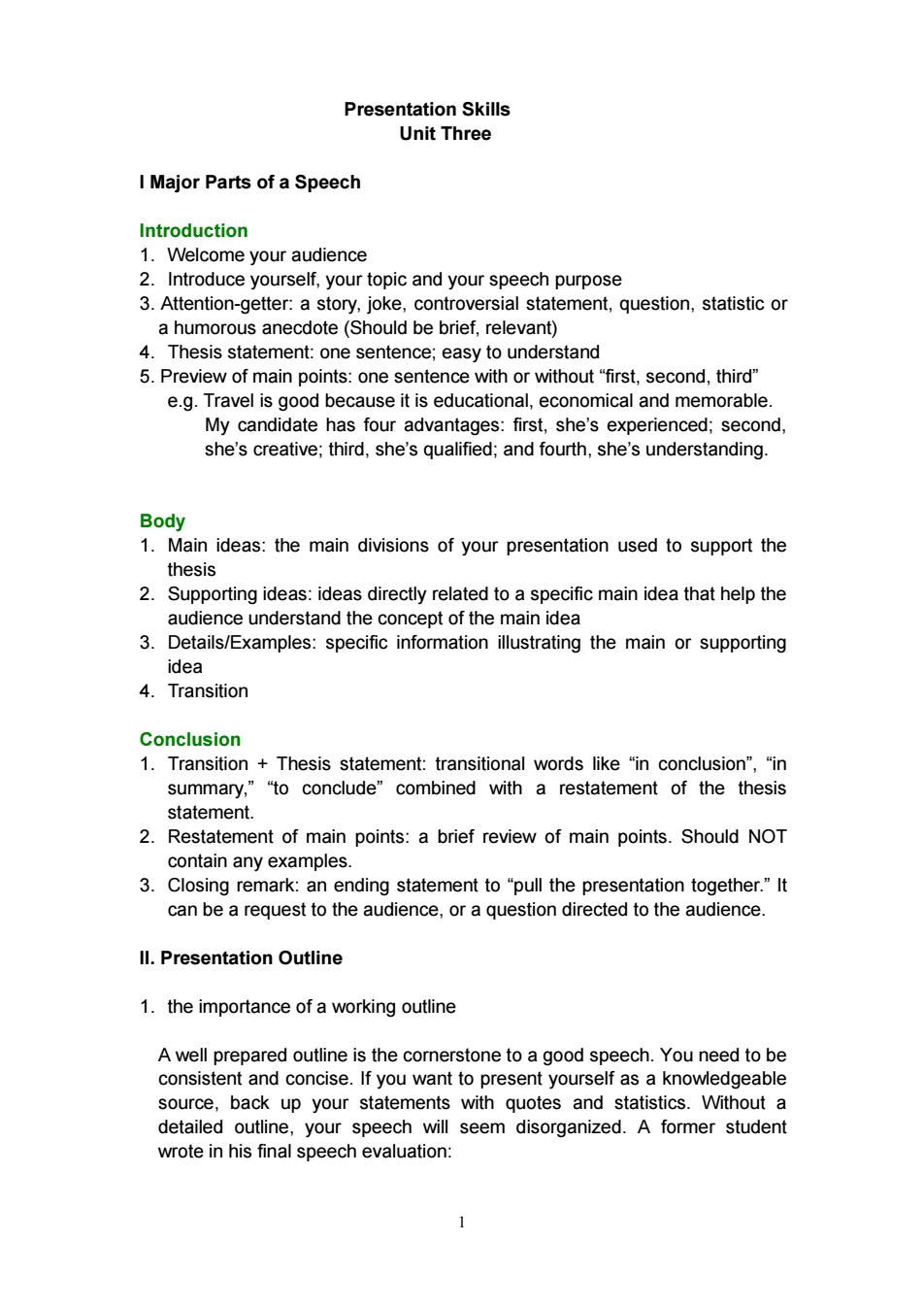
Presentation Skills Unit Three I Major Parts of a Speech Introduction 1.Welcome your audience 2.Introduce yourself,your topic and your speech purpose 3.Attention-getter:a story,joke,controversial statement,question,statistic or a humorous anecdote (Should be brief,relevant) 4.Thesis statement:one sentence;easy to understand 5.Preview of main points:one sentence with or without"first,second,third" e.g.Travel is good because it is educational,economical and memorable. My candidate has four advantages:first,she's experienced;second, she's creative;third,she's qualified;and fourth,she's understanding. Body 1.Main ideas:the main divisions of your presentation used to support the thesis 2.Supporting ideas:ideas directly related to a specific main idea that help the audience understand the concept of the main idea 3.Details/Examples:specific information illustrating the main or supporting idea 4.Transition Conclusion 1.Transition Thesis statement:transitional words like "in conclusion","in summary,""to conclude"combined with a restatement of the thesis statement. 2.Restatement of main points:a brief review of main points.Should NOT contain any examples. 3.Closing remark:an ending statement to "pull the presentation together."It can be a request to the audience,or a question directed to the audience. ll.Presentation Outline 1.the importance of a working outline A well prepared outline is the cornerstone to a good speech.You need to be consistent and concise.If you want to present yourself as a knowledgeable source,back up your statements with quotes and statistics.Without a detailed outline,your speech will seem disorganized.A former student wrote in his final speech evaluation:
1 Presentation Skills Unit Three I Major Parts of a Speech Introduction 1. Welcome your audience 2. Introduce yourself, your topic and your speech purpose 3. Attention-getter: a story, joke, controversial statement, question, statistic or a humorous anecdote (Should be brief, relevant) 4. Thesis statement: one sentence; easy to understand 5. Preview of main points: one sentence with or without “first, second, third” e.g. Travel is good because it is educational, economical and memorable. My candidate has four advantages: first, she’s experienced; second, she’s creative; third, she’s qualified; and fourth, she’s understanding. Body 1. Main ideas: the main divisions of your presentation used to support the thesis 2. Supporting ideas: ideas directly related to a specific main idea that help the audience understand the concept of the main idea 3. Details/Examples: specific information illustrating the main or supporting idea 4. Transition Conclusion 1. Transition + Thesis statement: transitional words like “in conclusion”, “in summary,” “to conclude” combined with a restatement of the thesis statement. 2. Restatement of main points: a brief review of main points. Should NOT contain any examples. 3. Closing remark: an ending statement to “pull the presentation together.” It can be a request to the audience, or a question directed to the audience. II. Presentation Outline 1. the importance of a working outline A well prepared outline is the cornerstone to a good speech. You need to be consistent and concise. If you want to present yourself as a knowledgeable source, back up your statements with quotes and statistics. Without a detailed outline, your speech will seem disorganized. A former student wrote in his final speech evaluation:
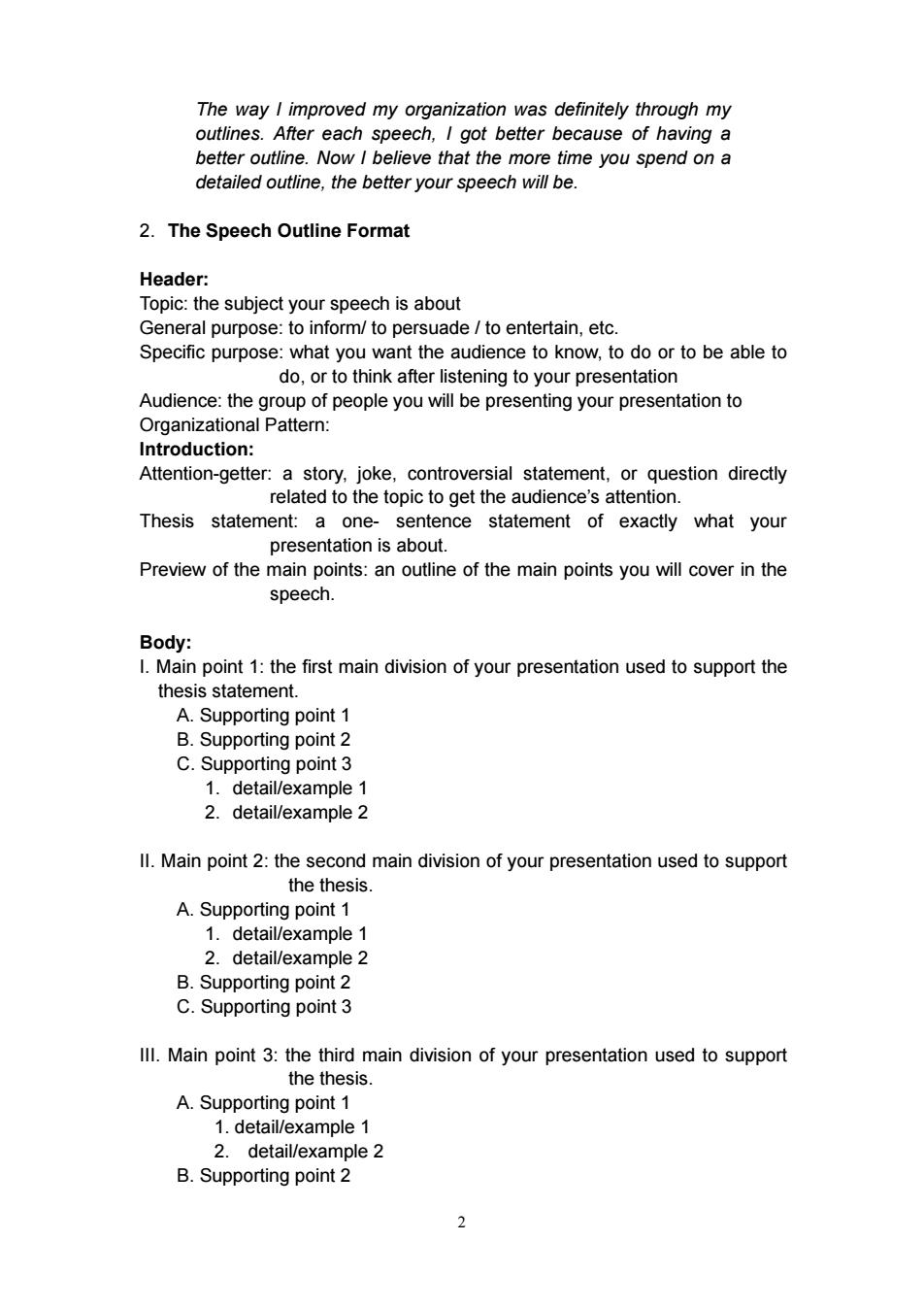
The way I improved my organization was definitely through my outlines.After each speech,I got better because of having a better outline.Now I believe that the more time you spend on a detailed outline,the better your speech will be. 2.The Speech Outline Format Header: Topic:the subject your speech is about General purpose:to inform/to persuade to entertain,etc. Specific purpose:what you want the audience to know,to do or to be able to do,or to think after listening to your presentation Audience:the group of people you will be presenting your presentation to Organizational Pattern: Introduction: Attention-getter:a story,joke,controversial statement,or question directly related to the topic to get the audience's attention. Thesis statement:a one-sentence statement of exactly what your presentation is about. Preview of the main points:an outline of the main points you will cover in the speech. Body: 1.Main point 1:the first main division of your presentation used to support the thesis statement. A.Supporting point 1 B.Supporting point 2 C.Supporting point 3 1.detail/example 1 2.detail/example 2 ll.Main point 2:the second main division of your presentation used to support the thesis A.Supporting point 1 1.detail/example 1 2.detail/example 2 B.Supporting point 2 C.Supporting point 3 Ill.Main point 3:the third main division of your presentation used to support the thesis. A.Supporting point 1 1.detail/example 1 2.detail/example 2 B.Supporting point 2 2
2 The way I improved my organization was definitely through my outlines. After each speech, I got better because of having a better outline. Now I believe that the more time you spend on a detailed outline, the better your speech will be. 2. The Speech Outline Format Header: Topic: the subject your speech is about General purpose: to inform/ to persuade / to entertain, etc. Specific purpose: what you want the audience to know, to do or to be able to do, or to think after listening to your presentation Audience: the group of people you will be presenting your presentation to Organizational Pattern: Introduction: Attention-getter: a story, joke, controversial statement, or question directly related to the topic to get the audience’s attention. Thesis statement: a one- sentence statement of exactly what your presentation is about. Preview of the main points: an outline of the main points you will cover in the speech. Body: I. Main point 1: the first main division of your presentation used to support the thesis statement. A. Supporting point 1 B. Supporting point 2 C. Supporting point 3 1. detail/example 1 2. detail/example 2 II. Main point 2: the second main division of your presentation used to support the thesis. A. Supporting point 1 1. detail/example 1 2. detail/example 2 B. Supporting point 2 C. Supporting point 3 III. Main point 3: the third main division of your presentation used to support the thesis. A. Supporting point 1 1. detail/example 1 2. detail/example 2 B. Supporting point 2
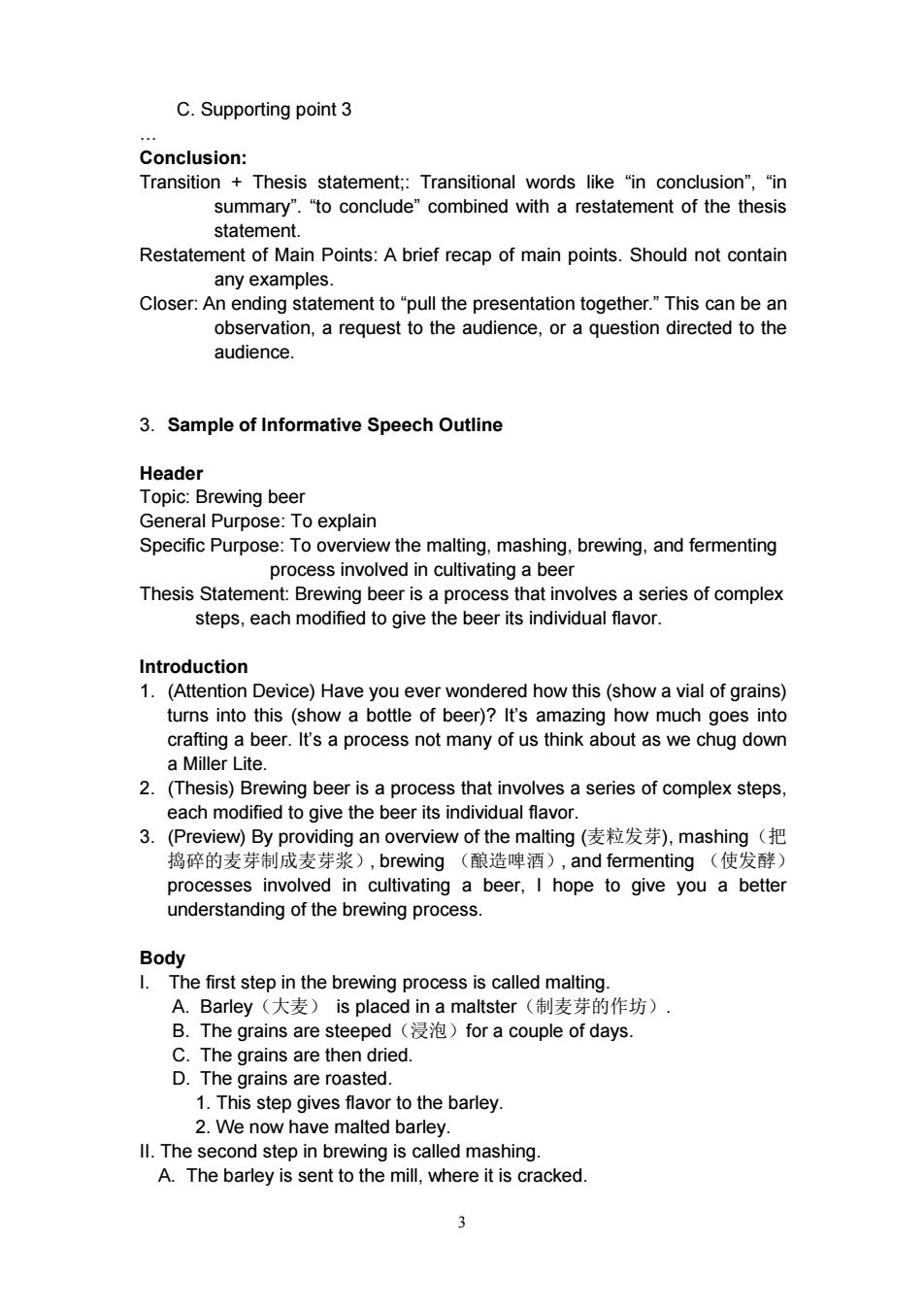
C.Supporting point 3 Conclusion: Transition Thesis statement;:Transitional words like "in conclusion","in summary'”.“to conclude”combined with a restatement of the thesis statement. Restatement of Main Points:A brief recap of main points.Should not contain any examples. Closer:An ending statement to"pull the presentation together."This can be an observation,a request to the audience,or a question directed to the audience. 3.Sample of Informative Speech Outline Header Topic:Brewing beer General Purpose:To explain Specific Purpose:To overview the malting,mashing,brewing,and fermenting process involved in cultivating a beer Thesis Statement:Brewing beer is a process that involves a series of complex steps,each modified to give the beer its individual flavor. Introduction 1.(Attention Device)Have you ever wondered how this(show a vial of grains) turns into this (show a bottle of beer)?It's amazing how much goes into crafting a beer.It's a process not many of us think about as we chug down a Miller Lite. 2.(Thesis)Brewing beer is a process that involves a series of complex steps, each modified to give the beer its individual flavor. 3.(Preview)By providing an overview of the malting(麦粒发芽),mashing(把 捣碎的麦芽制成麦芽浆),brewing(酿造啤酒),and fermenting(使发酵) processes involved in cultivating a beer,I hope to give you a better understanding of the brewing process. Body I.The first step in the brewing process is called malting. A.Barley(大麦)is placed in a maltster(制麦芽的作坊). B.The grains are steeped (for a couple of days. C.The grains are then dried. D.The grains are roasted. 1.This step gives flavor to the barley. 2.We now have malted barley. ll.The second step in brewing is called mashing A.The barley is sent to the mill,where it is cracked. 3
3 C. Supporting point 3 … Conclusion: Transition + Thesis statement;: Transitional words like “in conclusion”, “in summary”. “to conclude” combined with a restatement of the thesis statement. Restatement of Main Points: A brief recap of main points. Should not contain any examples. Closer: An ending statement to “pull the presentation together.” This can be an observation, a request to the audience, or a question directed to the audience. 3. Sample of Informative Speech Outline Header Topic: Brewing beer General Purpose: To explain Specific Purpose: To overview the malting, mashing, brewing, and fermenting process involved in cultivating a beer Thesis Statement: Brewing beer is a process that involves a series of complex steps, each modified to give the beer its individual flavor. Introduction 1. (Attention Device) Have you ever wondered how this (show a vial of grains) turns into this (show a bottle of beer)? It’s amazing how much goes into crafting a beer. It’s a process not many of us think about as we chug down a Miller Lite. 2. (Thesis) Brewing beer is a process that involves a series of complex steps, each modified to give the beer its individual flavor. 3. (Preview) By providing an overview of the malting (麦粒发芽), mashing(把 捣碎的麦芽制成麦芽浆), brewing (酿造啤酒), and fermenting (使发酵) processes involved in cultivating a beer, I hope to give you a better understanding of the brewing process. Body I. The first step in the brewing process is called malting. A. Barley(大麦) is placed in a maltster(制麦芽的作坊). B. The grains are steeped(浸泡)for a couple of days. C. The grains are then dried. D. The grains are roasted. 1. This step gives flavor to the barley. 2. We now have malted barley. II. The second step in brewing is called mashing. A. The barley is sent to the mill, where it is cracked
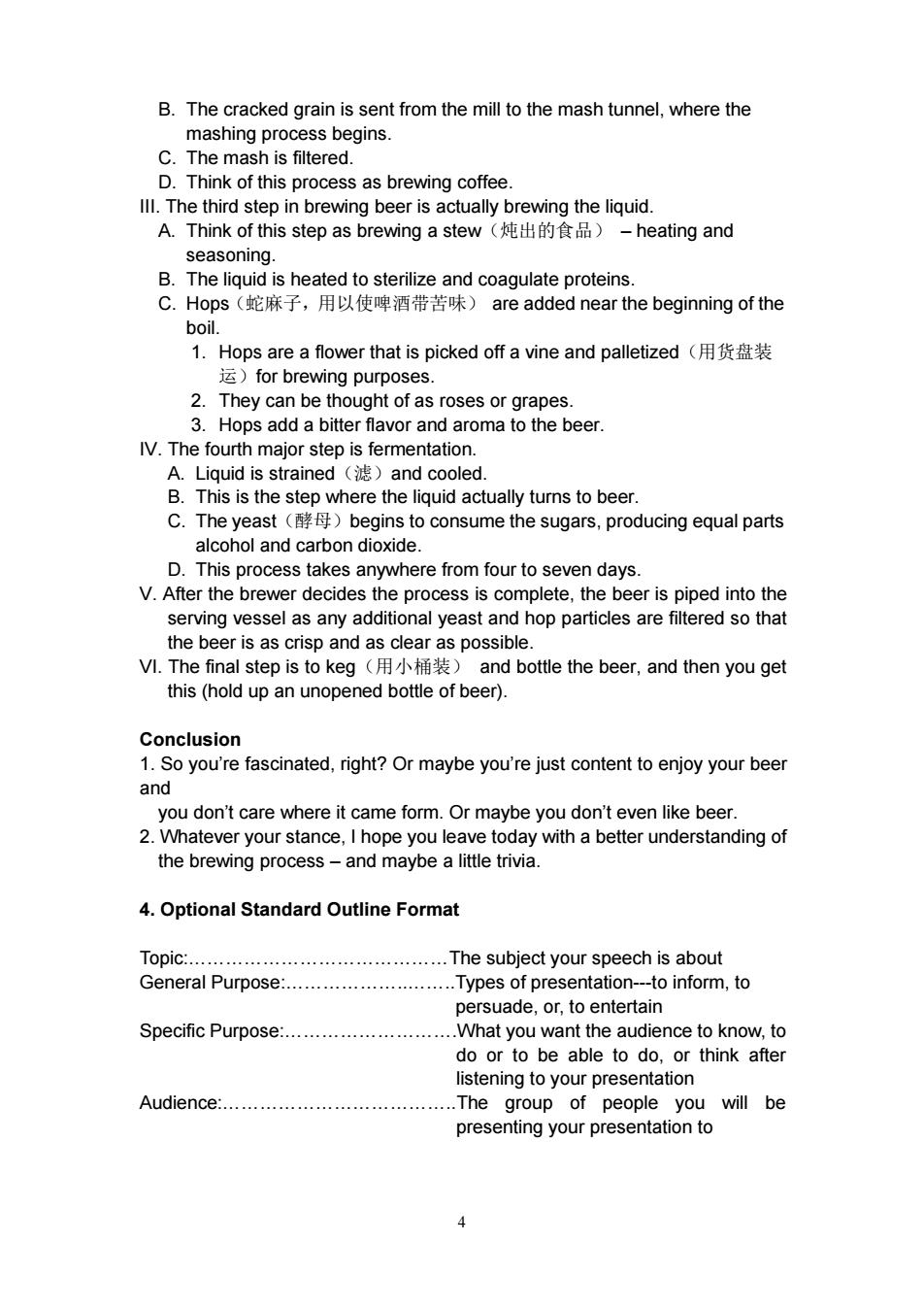
B.The cracked grain is sent from the mill to the mash tunnel,where the mashing process begins. C.The mash is filtered. D.Think of this process as brewing coffee Ill.The third step in brewing beer is actually brewing the liquid. A.Think of this step as brewing a stew(炖出的食品)-heating and seasoning. B.The liquid is heated to sterilize and coagulate proteins. C.Hops(蛇麻子,用以使啤酒带苦味)are added near the beginning of the boil. 1.Hops are a flower that is picked off a vine and palletized(用货盘装 for brewing purposes. 2.They can be thought of as roses or grapes. 3.Hops add a bitter flavor and aroma to the beer. IV.The fourth major step is fermentation. A.Liquid is strained (and cooled. B.This is the step where the liquid actually turns to beer. C.The yeast (begins to consume the sugars,producing equal parts alcohol and carbon dioxide. D.This process takes anywhere from four to seven days. V.After the brewer decides the process is complete,the beer is piped into the serving vessel as any additional yeast and hop particles are filtered so that the beer is as crisp and as clear as possible. Vl.The final step is to keg(用小桶装)and bottle the beer,.and then you get this (hold up an unopened bottle of beer). Conclusion 1.So you're fascinated,right?Or maybe you're just content to enjoy your beer and you don't care where it came form.Or maybe you don't even like beer. 2.Whatever your stance,I hope you leave today with a better understanding of the brewing process-and maybe a little trivia. 4.Optional Standard Outline Format Topic:..........................................The subject your speech is about General Purpose:............................Types of presentation---to inform,to persuade,or,to entertain Specific Purpose:......................What you want the audience to know,to do or to be able to do,or think after listening to your presentation Audience:.............................The group of people you will be presenting your presentation to
4 B. The cracked grain is sent from the mill to the mash tunnel, where the mashing process begins. C. The mash is filtered. D. Think of this process as brewing coffee. III. The third step in brewing beer is actually brewing the liquid. A. Think of this step as brewing a stew(炖出的食品) – heating and seasoning. B. The liquid is heated to sterilize and coagulate proteins. C. Hops(蛇麻子,用以使啤酒带苦味) are added near the beginning of the boil. 1. Hops are a flower that is picked off a vine and palletized(用货盘装 运)for brewing purposes. 2. They can be thought of as roses or grapes. 3. Hops add a bitter flavor and aroma to the beer. IV. The fourth major step is fermentation. A. Liquid is strained(滤)and cooled. B. This is the step where the liquid actually turns to beer. C. The yeast(酵母)begins to consume the sugars, producing equal parts alcohol and carbon dioxide. D. This process takes anywhere from four to seven days. V. After the brewer decides the process is complete, the beer is piped into the serving vessel as any additional yeast and hop particles are filtered so that the beer is as crisp and as clear as possible. VI. The final step is to keg(用小桶装) and bottle the beer, and then you get this (hold up an unopened bottle of beer). Conclusion 1. So you’re fascinated, right? Or maybe you’re just content to enjoy your beer and you don’t care where it came form. Or maybe you don’t even like beer. 2. Whatever your stance, I hope you leave today with a better understanding of the brewing process – and maybe a little trivia. 4. Optional Standard Outline Format Topic:……………………………………The subject your speech is about General Purpose:………………..……..Types of presentation---to inform, to persuade, or, to entertain Specific Purpose:……………………….What you want the audience to know, to do or to be able to do, or think after listening to your presentation Audience:………………………………..The group of people you will be presenting your presentation to
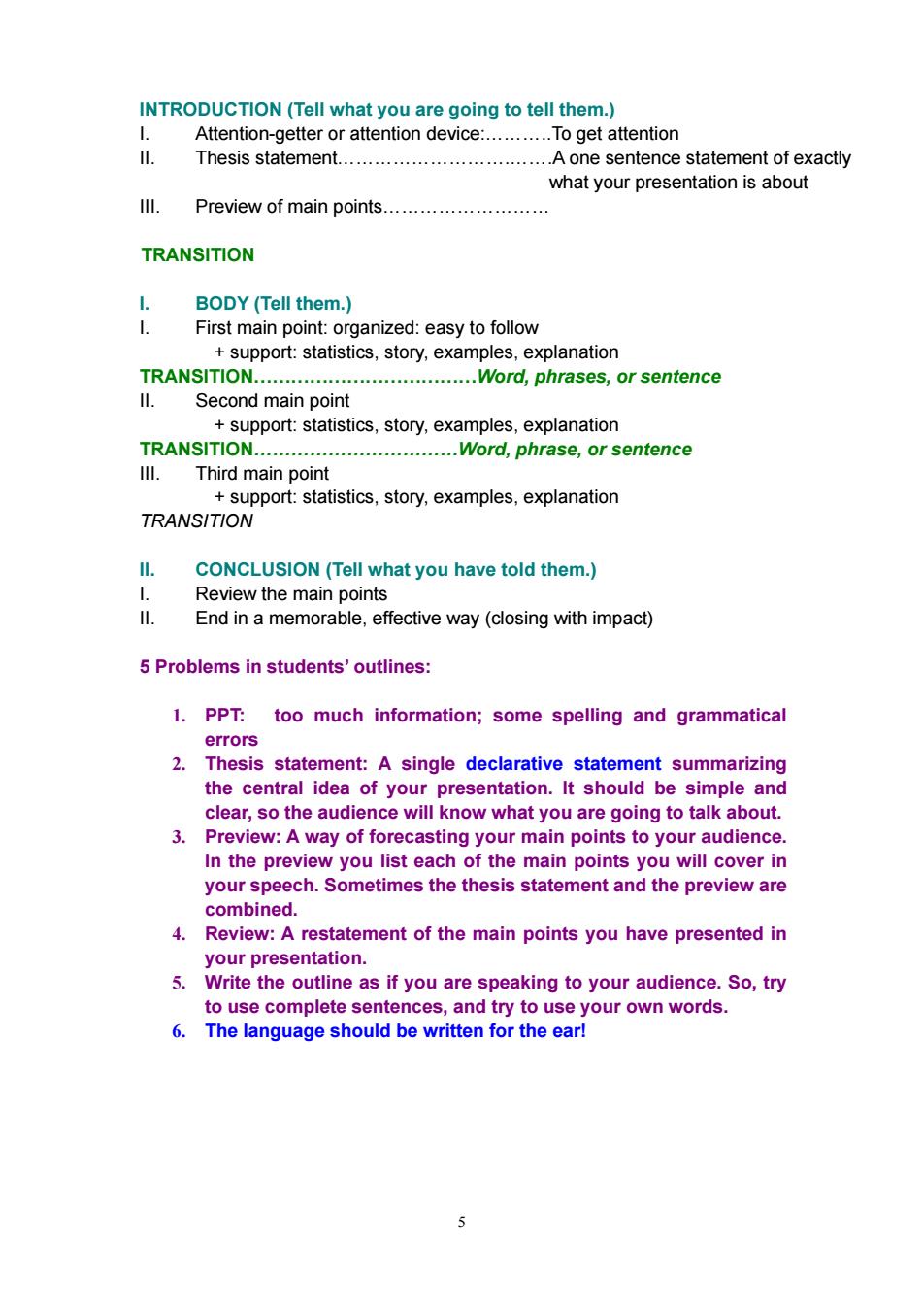
INTRODUCTION(Tell what you are going to tell them.) 1. Attention-getter or attention device:...........To get attention 1L. Thesis statement..................................A one sentence statement of exactly what your presentation is about ML. Preview of main points................... TRANSITION 1. BODY(Tell them.) L. First main point:organized:easy to follow support:statistics,story,examples,explanation TRANSITION...................................Word,phrases,or sentence Il. Second main point support:statistics,story,examples,explanation TRANSITION................................Word,phrase,or sentence ML. Third main point support:statistics,story,examples,explanation TRANSITION IL. CONCLUSION(Tell what you have told them.) ( Review the main points IL. End in a memorable,effective way(closing with impact) 5 Problems in students'outlines: 1.PPT:too much information;some spelling and grammatical errors 2.Thesis statement:A single declarative statement summarizing the central idea of your presentation.It should be simple and clear,so the audience will know what you are going to talk about. 3.Preview:A way of forecasting your main points to your audience. In the preview you list each of the main points you will cover in your speech.Sometimes the thesis statement and the preview are combined. 4.Review:A restatement of the main points you have presented in your presentation. 5.Write the outline as if you are speaking to your audience.So,try to use complete sentences,and try to use your own words. 6.The language should be written for the ear! 5
5 INTRODUCTION (Tell what you are going to tell them.) I. Attention-getter or attention device:………..To get attention II. Thesis statement……………………….…….A one sentence statement of exactly what your presentation is about III. Preview of main points……………………… TRANSITION I. BODY (Tell them.) I. First main point: organized: easy to follow + support: statistics, story, examples, explanation TRANSITION………………………………Word, phrases, or sentence II. Second main point + support: statistics, story, examples, explanation TRANSITION……………………………Word, phrase, or sentence III. Third main point + support: statistics, story, examples, explanation TRANSITION II. CONCLUSION (Tell what you have told them.) I. Review the main points II. End in a memorable, effective way (closing with impact) 5 Problems in students’ outlines: 1. PPT: too much information; some spelling and grammatical errors 2. Thesis statement: A single declarative statement summarizing the central idea of your presentation. It should be simple and clear, so the audience will know what you are going to talk about. 3. Preview: A way of forecasting your main points to your audience. In the preview you list each of the main points you will cover in your speech. Sometimes the thesis statement and the preview are combined. 4. Review: A restatement of the main points you have presented in your presentation. 5. Write the outline as if you are speaking to your audience. So, try to use complete sentences, and try to use your own words. 6. The language should be written for the ear!